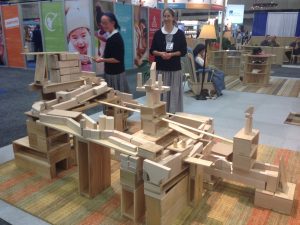Math and Social- Emotional Development Work Hand in Hand
One of my favorite activities in an early childhood environment is block play. Blocks and block areas are a natural place for multiple children to hang out together, work together and bring to life what they see in their mind’s eye. There have been times where the children are so engaged that we must save their creations for days on end while they add or rearrange the blocks and create more elaborate structures. I have observed children building roadways, castles, houses, schools, farms, cities, ships and basically anything they can imagine. Bringing in found objects, loose parts and materials from other areas, extends their creation and provides opportunities for interactive and dramatic play all while building.
So, how does the block are relate to math?
Blocks are the visual representation of geometric concepts. Blocks can be any size, from very small cubes to large wooden hollow blocks. They come in almost every shape available and are three dimensional; such as squares, triangles, ramps, planks, tubes, columns, arches, rectangles, cubes, spheres, half circles, etc. By using blocks, children are actively and physically creating what they see in their minds, using spatial relationships, balance, weight, height, form of measurement, sorting, fractions and so much more. It becomes a chance for every child to become a master architect and construction foreman. Besides, building with blocks is so much more fun than matching shapes on paper.
So, how does the block area then relate to social and emotional development?
When children are gathered in the block area, building with the physical representation of geometric concepts, they are also interacting with one another. Being a shared space in most early childhood environments, block areas are often large and can accommodate between 4-6 children. The blocks are divided up between children or children work together with one common set. Negotiations take place when children both want the same plank. Children are able to take turns to each put a block on the growing tower before it falls down and everyone cheers. When building a farm with blocks and plastic farm animals, children take on roles of being the farmer or the anxious animals waiting for their food. Cars come alive as children race them on the ramps and planks, cheering each other on as they race to the finish line. Ultimately, children interact with one another on a common and shared space to create, negotiate, problem solve, imagine and build their dream creation. Blocks are play at its finest. Play is the best method of learning and experiencing social and emotional development. Block play allows the seamless integration of social and emotional development and cognitive development every time.
A great article reminding me of the importance of block play in the social and emotional development of children in our care. I will pass on it.
A great article, reminding me of the importance of block play!
“Negotiations take place when children both want the same plank. Children are able to take turns to each put a block on the growing tower before it falls down and everyone cheers. Blocks are play at its finest. Play is the best method of learning and experiencing social and emotional development. Block play allows the seamless integration of social and emotional development and cognitive development every time.”
This statement expresses the true sense of the Block/Construction area. The back and forth conversation between the children is vital to their social development. They learn to use words that express their design, their expectations, their delight with the outcome being being a new creation or the squeals of joy when their tower tumbles.
The bloks are the visual representation of geometric concepts. Blocks can be to represent size. They come in almost every shape available and are three dimensional; such as squares, triangles, ramps, planks, tubes, columns, arches, rectangles, cubes, spheres, half circles. By using blocks, children are actively and physically creating what they see in their minds, using spatial relationships, balance, weight, height, form of measurement, sorting, fractions Is excelent fir kids building with blocks is so much more fun than use paper.
A great post informing me of the importance of block play. I will use this information in my classroom.